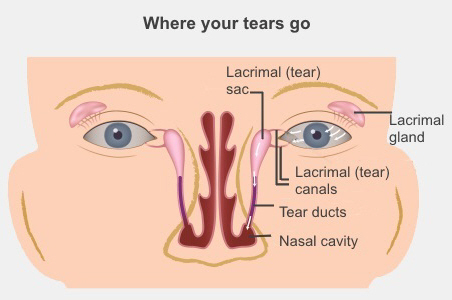Watery eyes Ngā karu waiwai
When we produce too many tears or our tears cannot drain properly from our eyes, we get watery eyes (also called epiphora) and tears constantly roll onto our cheeks. This is not normal. You can get watery eyes at any age, but it is more common in young pēpi (babies) and people over the age of 60. It can affect one or both eyes.
Causes of watery eyes
Two things are likely to cause watery eyes:
- you are making too many tears
- your tears are not draining properly.
Too many tears
Too many tears are usually caused by irritation or inflammation on the surface of your eye. This can happen for several reasons, including eyelash and eyelid problems or allergies. A dry eye problem can sometimes cause watery eyes because the eye produces excess tears to combat the irritation and dryness.
Poor tear drainage
Your tears might not be draining properly because you have:
- a blocked tear duct
- tear drainage openings that are too narrow or in the wrong place
- droopy eyelids (also called ectropion). If your lower eyelid turns outwards, tears might roll off the bottom of your eyelid, rather than into your tear ducts.
Some pēpi are born with a tear duct that has not fully opened. This usually opens fully by one year, without any treatment. If this applies to your pēpi, clear any discharge from their lids with warm water. Pēpi usually do not need to use antibiotic drops.

Symptoms of watery eyes
The most obvious symptom of watery eyes is having tears running or dripping from your eyes. But other things may also indicate you have watery eyes, even if tears are not running down your cheeks. These include:
- blurred vision
- glassy-looking eyes (caused by too many tears)
- sore skin around your eyes (caused by constantly wiping the tears away)
- a runny nose
- eyes that constantly itch or sting
- a feeling that there is something in your eyes
- crusting around your eyes (caused by blocked tear ducts)
- eye pain (especially if you have had an injury)
- bloodshot eyes.
- red eyes
- discharge from your eyes
- pain in your eyes or nose
- watery eyes for a long period of time.
Diagnosing watery eyes
Sometimes the cause of your watery eyes will be obvious, such as if you have:
- an infection
- turned-in lashes
- conjunctivitis.
If the cause is not obvious, you will need more tests to find out what is happening. Contact your optometrist or ophthalmologist.
Treating watery eyes
The treatment will depend on what is causing your watery eyes. If you are producing too many tears, it may involve:
- removing the irritating eyelash or grit
- using drops to treat conjunctivitis
- using artificial tears (if your eye is producing too many tears to compensate for being dry)
- cleaning your eyelashes regularly and applying warm compresses, especially if you have an eyelid inflammation (blepharitis)
- taking omega-3 supplements or fish oil
- taking other prescribed medicines.
Surgery
Surgery might help if your eyelids are turned outwards (this is called ectropion). This is a common operation. It is done with a local anaesthetic injection that numbs the area.
If your tears are not draining properly, you are likely to have surgery to help them drain. The usual operation makes a new channel to the inside of your nose, which your tears can drain through. The operation is called a dacrocystorhinostomy (or DCR).
Another less common operation uses a tiny balloon to make the tear duct wider or inserts a small device (called a stent) to hold the tear duct open.
To help avoid watery eyes, make sure you wear sunglasses when you are outside to protect your eye from UV rays and dust and reduce glare.